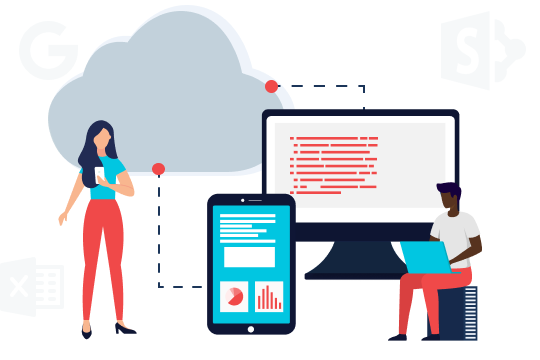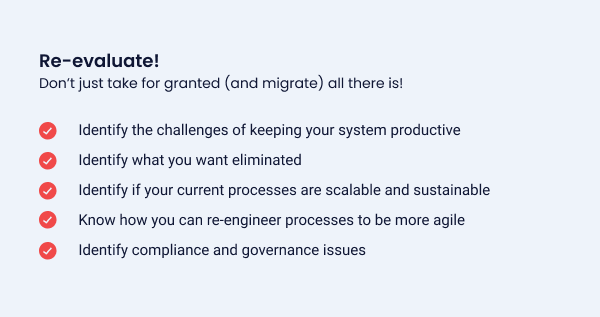How to migrate legacy apps to the cloud with a low-code platform like ServiceNow

If you’re considering to migrate legacy apps to the cloud, taking the first steps can be daunting. We’ve been there ourselves. But why struggle? When you can benefit from best practices that we’ve accumulated helping customers switch from legacy systems to the low-code ServiceNow platform.
We’ve even drawn up a 5-step plan that covers all key considerations for a successful app cloud migration. Follow these steps and build scalable delivery processes that will lead transformation in your organization.
5 Steps to safely move legacy apps to the cloud
1. Discovery
This step is essential before you consider any kind of migration. It involves getting a full understanding of what apps are running in your organization. Get the full picture: from big (usual legacy systems) to small, including stuff like MS Access data bases and Excel. After all, if you don’t know what you have, you won’t know what is needed to migrate your apps to the cloud.
For this purpose, we recommend using ServiceNow Asset Management and Discovery to oversee your full infrastructure and detect and consolidate your software assets. It will help you acquire an accurate, up to date and single system of record for all your IT assets. Mapping your assets in this way, enables you to manage the move to the cloud in a proactive way based on a well-configured CMDB containing data that is current and reliable.
2. Identify
The next step to migrate legacy apps to the cloud is to see which of the apps that you have defined as being used in your organization, actually fit on the ServiceNow platform and which do not. Typically, we see that 80% of all apps that are up and running within an organization can be migrated. The remaining 20% need to be migrated to another cloud platform.
Know to what extent—and where—are your employees and business units using tools like Excel, SharePoint, MS Access, Google Apps, client services apps to automate day-to-day activities. Hard to maintain and disconnected from other flows, such tools are inherently hard to scale. But can be easily migrated to ServiceNow.
Important also for a successful migration is—at this stage—to identify not only mission-critical apps, but also critical processes, current gaps and key functional requirements that are vital to your company.
It can be useful here to get in an expert who has a full understanding of what ServiceNow can mean for you organization and make sure you focus your efforts and manpower effectively.
3. Plan
Migration of your apps to the cloud requires time and effort, involving many people and departments. We advise that you plan carefully. Clear planning avoids chaos.
- Build
Get in place an expert team—or so-called Centre of Excellence—which defines the objective and outcomes of your migration. Such a team should work according to a clear governance model and consist of experts on all touch points involved, like architects, quality control, platform owner and more. They are responsible for safeguarding the quality of the platform, for ensuring that not every application generates its own double data and for creating communities of practice around certain knowledge points, like reporting.
- Prioritize
This is all about making sure you know what you want out of your new system. For instance, what are the things that you weren’t getting out of your legacy apps? You’ll want to make sure you get them from now on! Rate your current apps to how they are used and how critical they are to your business. Also define how complex your apps are. To be able to do such prioritization properly, it’s essential to have an architect on board your migration team. S/he can determine if and how any app can function in ServiceNow.
- Trial & error
Start with what we call the low-hanging fruit. We often get asked at this stage why we don’t recommend starting off with business-critical apps. They’re the important ones, right? Right! Two things are for sure when you migrate: no one migration is the same and all migrations are complex, typically involving hundreds of apps. And that’s why it makes more sense to try out your first moves to the cloud with a non-critical app. It’s best to try things out on not-so-important apps and apply your lessons learned on successfully migrating the more complex and essential stuff.
- Categorize
Determine which apps are suitable for citizen development and which not. In other words, can you train your end users or designated persons in a department to make the app themselves or do you need IT or other external experts to migrate certain expert apps? Answering this question will be the very basis for determining how you are going to migrate an app.
4. Build
This step involves building the custom apps that you need to streamline your workflow, while ensuring you don’t end up re-inventing the wheel and doing the same thing over and over during your whole migration. Why so? Because many apps have similar or common features, for instance: the ability to assign work to a certain person. One of the benefits of a low-code platform like ServiceNow is that it uses a shared database. Such a shared CSDM enables you to benefit from the data collected by others within your organization. Or in our example: assign work to a person using data collected from another app.
So, the question that needs to be answered here is: how do you align your apps with your CSDM and avoid entering data twice in two (or more) different places? The common features and your shared database should define your build blueprint. In turn, this blueprint defines the steps that must be taken in the migration of every single app.
However, what we see is that many companies lack the manpower to streamline their cloud migration, as well as build ServiceNow applications. It’s here that we are regularly called in to help take the necessary steps, including:
- Identifying opportunities
- Building the business case
- Training your expert team and citizen developers
- Building reusable pro-code components to complete the value case
- Assisting in designing and building applications
- Training your experts to be self-sufficient
5. Migrate
Now it’s time to do the actual migrating. Total migrations can cost anything up to 2 or 3 years. The good news is, though that despite the length of time required, it doesn’t need to be complicated.
There are 3 ways to approach migration:
The big bang approach is undeniably the most complex approach. With migration involving mainly testing and user testing, a big bang puts maximum strain on your IT resources.
It’s why we recommend a wave or phased approach which allows you to migrate on average 10 apps in 2 to 3 months. By keeping old and new systems running parallel, there is no downtime and no impact on your critical services. Done well, it lets you set the pace for quick migration of non-complex apps, as well as giving you spend longer and focus on getting the more complex or critical ones done right.
Our longstanding experience creating custom ServiceNow applications, resulted in being recognized as the ServiceNow Global App Development Platform Partner of the Year 2021. We can truly say we know what’s necessary to migrate legacy apps to the cloud using the Now platform.
Join 1400+ ServiceNow professionals
Sign up to our monthly Flow@Work Exclusive newsletter to get free access to our expertise and lots of tips and tricks to make work flow on the Now® Platform.







